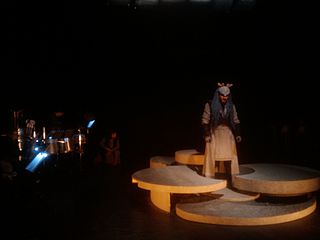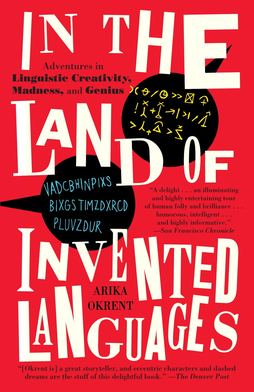
Fictional languages are the subset of constructed languages (conlangs) that have been created as part of a fictional setting. Typically they are the creation of one individual, while natural languages evolve out of a particular culture or people group, and other conlangs may have group involvement. Fictional languages are also distinct from natural languages in that they have no native speakers. By contrast, the constructed language of Esperanto now has native speakers.
The Klingon language is the constructed language spoken by a fictional alien race called the Klingons, in the Star Trek universe.

Marc Okrand is an American linguist. His professional work is in Native American languages, and he is well known as the creator of the Klingon language in the Star Trek science fiction franchise.

Kahless "The Unforgettable" is a fictional character from the Star Trek media franchise. He was displayed as a portrait in Star Trek: The Original Series by Robert Herron and in Star Trek: The Next Generation by Kevin Conway; and is the titular character in the Star Trek novel Kahless by Michael Jan Freeman. Kahless is an important religious and historical figure to the Klingon race and has been studied in explorations of the philosophy within the setting of Star Trek.
Seediq, also known as Sediq, Taroko, is an Atayalic language spoken in the mountains of Northern Taiwan by the Seediq and Taroko people.

Mutsun is a Utian language spoken in Northern California. It was the primary language of a division of the Ohlone people living in the Mission San Juan Bautista area. The Tamien Nation and Amah Mutsun band is currently working to restore the use of the language, using a modern alphabet.
The Klingon scripts are fictional alphabetic scripts used in the Star Trek movies and television shows to write the Klingon language.
Scandoromani is a North Germanic based Para-Romani language. It is spoken by the Scandinavian Romanisæl Travellers, a Romani minority community, in Norway, and formerly in Sweden.

Kusunda is a language isolate spoken by a few among the Kusunda people in western and central Nepal. As of 2023, it only has a single fluent speaker, Kamala Khatri Sen, although there are efforts underway to keep the language alive.

The Klingon Language Institute (KLI) is an independent organization originally founded in Flourtown, Pennsylvania and now located in Kentucky. Its goal is to promote the Klingon language, a constructed language from the Star Trek fictional universe, as well as Klingon culture.

A constructed language is a language whose phonology, grammar, and vocabulary, instead of having developed naturally, are consciously devised for some purpose, which may include being devised for a work of fiction. A constructed language may also be referred to as an artificial, planned or invented language, or a fictional language. Planned languages are languages that have been purposefully designed; they are the result of deliberate, controlling intervention and are thus of a form of language planning.

The Klingons are a fictional species in the science fiction franchise Star Trek.
Verdurian is a constructed language created by Mark Rosenfelder, first published in 1995 and hosted at his website, Zompist.com.

ʼuʼ is the first opera in the Klingon language, billed as "The first authentic Klingon opera on Earth". It was composed by Eef van Breen to a libretto by Kees Ligtelijn and Marc Okrand under the artistic direction of Floris Schönfeld. The story of ʼuʼ is based on the epic legend of "Kahless the Unforgettable", a messianic figure in the history of the fictional Klingon species.
The grammar of the Klingon language was created by Marc Okrand for the Star Trek franchise. He first described it in his book The Klingon Dictionary. It is a nominative–accusative, primarily suffixing agglutinative language, and has an object–verb–subject word order. The Klingon language has a number of unusual grammatical features, as it was designed to sound and seem alien, but it has an extremely regular morphology.
There are several crucial differences between Lojban and Loglan, two logical constructed languages. The main one is of the sounding of the core words, which, however, have similar phonotactics in both languages. Most grammatical particles also sound differently. Lojban alphabet lacks the letters q, w, h, but has the letter x and ' (apostrophe).

The Klingon Way: A Warrior's Guide is a 1996 book by the linguist Marc Okrand that was published by Pocket Books. The Klingon Way is a collection of proverbs and sayings in the constructed language of Klingon, ascribed to the Klingon race and Klingon culture in the fictional Star Trek universe. Okrand first began constructing the Klingon language in the 1980s when he was hired to produce Klingon dialogue for Star Trek III: The Search for Spock, going on to publish The Klingon Dictionary. The Klingon Way expanded the Klingon lexicon, and was followed by Klingon for the Galactic Traveler.
A formal description of an alien language in science fiction may have been pioneered by Percy Greg's Martian language in his 1880 novel Across the Zodiac, although already the 17th century book The Man in the Moone describes the language of the Lunars, consisting "not so much of words and letters as tunes and strange sounds", which is in turn predated by other invented languages in fictional societies, e.g., in Thomas More's Utopia.

Klingon for the Galactic Traveler (KGT) is the third book written by Marc Okrand about the Klingon language. It was published in 1997.

In the Land of Invented Languages: Esperanto Rock Stars, Klingon Poets, Loglan Lovers, and the Mad Dreamers who Tried to Build a Perfect Language is a 2009 non-fiction book by linguist Arika Okrent about the history and culture of constructed languages, or conlangs, languages created by individuals. Okrent explores the motivations for creating a language, the challenges faced by such projects, and the outcomes of a number of high-profile conlangs. The book revolves around six conlangs: John Wilkins' unnamed 'philosophical language', Esperanto, Blissymbols, Loglan and its descendant Lojban, and the Klingon language designed for the Star Trek universe. Okrent describes her personal experiences learning and interacting with these languages and their speakers, and provides historical and linguistic analyses of their structures and features.












